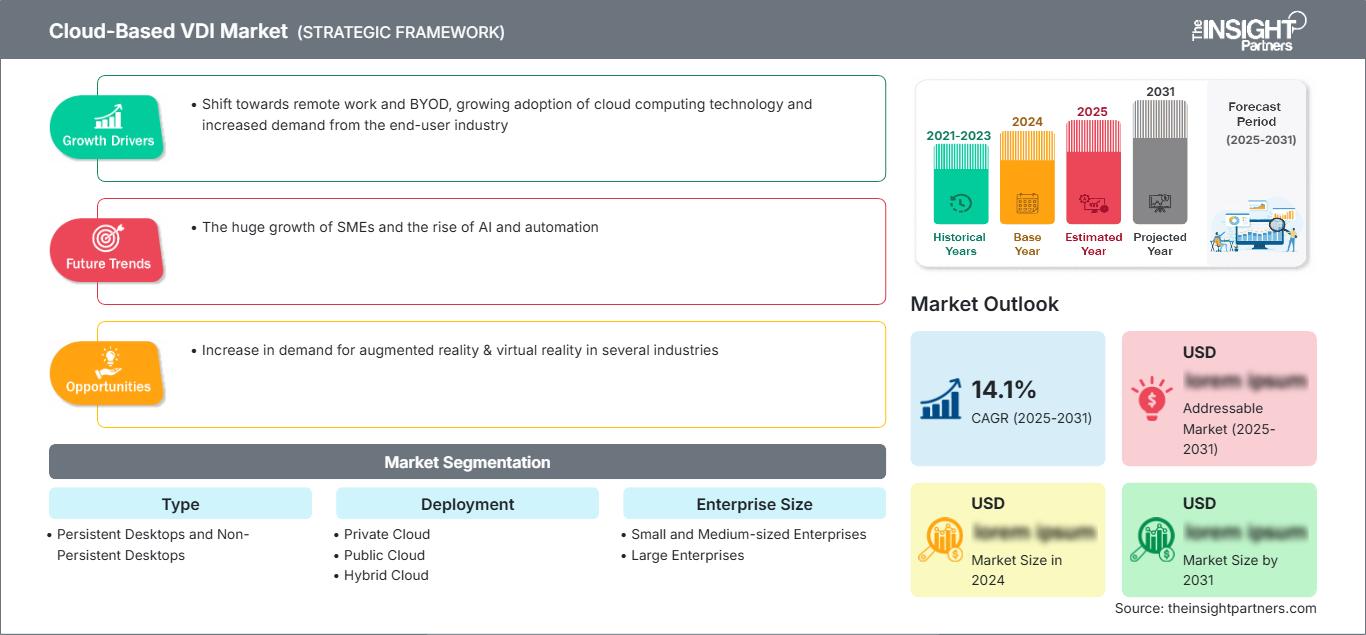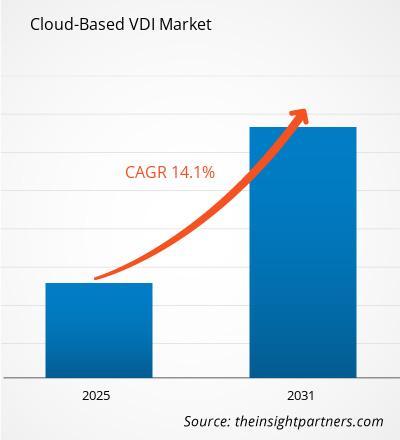Der Markt für Cloud-basierte Video-Delivery-Systeme (VDI) wird bis 2031 voraussichtlich ein Volumen von 33,61 Milliarden US-Dollar erreichen. Für den Zeitraum 2025–2031 wird ein jährliches Wachstum von 31,9 % erwartet. Die steigende Nachfrage nach Augmented Reality (AR) und Virtual Reality (VR) in verschiedenen Branchen dürfte weiterhin ein wichtiger Markttrend sein.
Marktanalyse für cloudbasierte VDI-Lösungen
- Der Markt für cloudbasierte VDI-Lösungen bietet Wachstumsperspektiven aufgrund der aktuellen Markttrends und ihrer absehbaren Auswirkungen im Prognosezeitraum.
- Der Markt für cloudbasierte VDI-Lösungen wächst aufgrund von Faktoren wie der Verlagerung hin zu Remote-Arbeit und BYOD, der zunehmenden Nutzung von Cloud-Computing-Technologien und der steigenden Nachfrage aus der Endnutzerbranche.
- Das enorme Wachstum von KMU und der Aufstieg von KI und Automatisierung bieten lukrative Möglichkeiten für den Markt für cloudbasierte VDI-Lösungen.
Marktübersicht für cloudbasierte VDI-Lösungen
- Da Cloud Computing immer beliebter wird, setzen immer mehr Unternehmen auf cloudbasierte Virtual Desktop Infrastructure (VDI)-Lösungen, um die IT-Kosten zu senken und die Desktop-Administration zu optimieren.
- Cloud-VDI-Lösungen bieten Unternehmen die Skalierbarkeit und Flexibilität, die sie benötigen, um sich an die sich ständig ändernden Bedürfnisse der Unternehmenswelt anzupassen.
- Mit dem technologischen Fortschritt werden VDI-Lösungen zunehmend mit anderen Technologien wie Cloud Computing und künstlicher Intelligenz verknüpft, wodurch Unternehmen von diesen Innovationen profitieren können.
Sie erhalten eine kostenlose Anpassung aller Berichte – einschließlich Teilen dieses Berichts, Länderanalysen und Excel-Datenpaketen – sowie attraktive Angebote und Rabatte für Start-ups und Universitäten.
Markt für cloudbasierte VDI-Lösungen: Strategische Einblicke

-
Ermitteln Sie die wichtigsten Markttrends dieses Berichts.Diese KOSTENLOSE Probe beinhaltet eine Datenanalyse, die von Markttrends bis hin zu Schätzungen und Prognosen reicht.
Markttreiber und Chancen für cloudbasierte VDI-Lösungen
Verlagerung hin zu Remote-Arbeit und BYOD begünstigt den Markt
- Die Möglichkeit, jederzeit und von überall aus zu arbeiten, ist für Arbeitnehmer in der schnelllebigen Geschäftswelt von heute unerlässlich.
- Laut Cass Information Systems, Inc. liegt die durchschnittliche BYOD-Nutzungsrate weltweit bei 70 %. Jamf zufolge nutzten im Juli 2023 rund 75 % der Beschäftigten private Geräte für Büroarbeiten, was zu einer Produktivitätssteigerung von 34 % führte. Zudem können Unternehmen mit einer BYOD-Richtlinie inklusive Zuschuss pro Mitarbeiter etwa 250 US-Dollar einsparen.
- Unternehmen können ihren Mitarbeitern die Freiheit geben, von privaten Geräten aus zu arbeiten und gleichzeitig die Sicherheits- und Compliance-Vorschriften einzuhalten, indem sie Bring Your Device (BYOD)-Richtlinien und mobile virtuelle Desktop-Infrastrukturtechnologie (VDI) implementieren.
- Zunehmende BYOD- und Remote-Arbeitsrichtlinien geben ebenfalls Anlass zu Sicherheitsbedenken. Da die Anzahl der mobilen Geräte, die für den Zugriff auf Unternehmensdaten genutzt werden, steigt, setzen Unternehmen verstärkt auf Sicherheitsmaßnahmen, um vertrauliche Daten vor Gefahren wie Malware und unbefugtem Zugriff zu schützen.
- In einem solchen Szenario hilft Cloud-VDI dabei, strenge Sicherheitsrichtlinien, Ende-zu-Ende-Verschlüsselung und Zugriffskontrollen einzuführen und so sicherzustellen, dass die Mitarbeiter nur Zugriff auf die Daten haben, die sie zur Erledigung ihrer Aufgaben benötigen.
Aufstieg von KI und Automatisierung
- Die Zukunft von VDI wird maßgeblich von der anhaltenden Betonung des Potenzials von Automatisierung und künstlicher Intelligenz beeinflusst werden.
- Organisationen erkennen, dass sie leistungsstarke KI-Systeme benötigen, um die stetig wachsende Menge an Daten, die sie produzieren, zu steuern, zu verwalten und auszuwerten, um daraus Erkenntnisse zu gewinnen.
- Mit dem Aufkommen von dialogorientierter KI und Deep Inference, die unsere Interaktionen mit Apps und Geräten verbessern und vermenschlichen, beeinflusst künstliche Intelligenz (KI) immer mehr Bereiche des täglichen Lebens von Konsumenten und Arbeitnehmern.
- Ein Schlüsselelement von VDI wird die Fähigkeit sein, die Prozessbereitstellung durch intelligente Automatisierung effektiv zu optimieren. Dies kann Unternehmen dabei unterstützen, Geschäftsprozesse zu optimieren, von der einfachen Aufgabenautomatisierung bis hin zur komplexeren Automatisierung von Finanzdienstleistungen.
- In den kommenden Jahren werden Organisationen dank der kontinuierlichen Betonung des Potenzials von KI und Automatisierung noch mehr Möglichkeiten zur Verfügung stehen, um Sicherheit, Flexibilität und Produktivität zu verbessern.
Marktbericht für cloudbasierte VDI-Lösungen: Segmentierungsanalyse
Die wichtigsten Segmente, die zur Ableitung der Marktanalyse für Cloud-basierte VDI beigetragen haben, sind Typ, Bereitstellung, Unternehmensgröße und Endnutzer.
- Nach Produkttyp lässt sich der Markt in persistente Desktops und nicht-persistente Desktops unterteilen.
- Nach Bereitstellungsart ist der Markt in Private Cloud, Public Cloud und Hybrid Cloud unterteilt.
- Nach Unternehmensgröße wird der Markt in kleine und mittlere Unternehmen (KMU) und große Unternehmen unterteilt.
- Nach Endnutzer ist der Markt in Banken, Finanzdienstleistungen und Versicherungen (BFSI), IT und Telekommunikation, Gesundheitswesen, Bildung, Regierung, Fertigung und Sonstige unterteilt.
Marktanteilsanalyse für cloudbasierte VDI-Lösungen nach Regionen
- Der Marktbericht für Cloud-basierte VDI-Lösungen enthält eine detaillierte Analyse von fünf wichtigen geografischen Regionen, einschließlich der aktuellen und historischen Marktgröße sowie Prognosen für den Zeitraum von 2021 bis 2031, und deckt Nordamerika, Europa, den asiatisch-pazifischen Raum (APAC), den Nahen Osten und Afrika (MEA) sowie Süd- und Mittelamerika ab.
- Jede Region ist weiter in einzelne Länder unterteilt. Dieser Bericht bietet Analysen und Prognosen für über 18 Länder und deckt die Marktdynamik cloudbasierter VDI-Lösungen ab, darunter Treiber, Trends und Chancen, die die Märkte auf regionaler Ebene beeinflussen.
- Der Bericht umfasst außerdem eine PEST-Analyse, bei der die wichtigsten Faktoren untersucht werden, die den Markt für cloudbasierte VDI-Lösungen in diesen Regionen beeinflussen.
Markteinblicke in den Cloud-basierten VDI-Markt
Die regionalen Trends und Einflussfaktoren auf den Markt für Cloud-basierte VDI-Lösungen im gesamten Prognosezeitraum wurden von den Analysten von The Insight Partners ausführlich erläutert. Dieser Abschnitt behandelt außerdem die Marktsegmente und die geografische Verteilung des Cloud-basierten VDI-Marktes in Nordamerika, Europa, Asien-Pazifik, dem Nahen Osten und Afrika sowie Süd- und Mittelamerika.
Berichtsumfang zum Markt für cloudbasierte VDI-Lösungen
| Berichtattribute | Details |
|---|---|
| Marktgröße im Jahr 2024 | US$ XX Milliarden |
| Marktgröße bis 2031 | 33,61 Milliarden US-Dollar |
| Globale durchschnittliche jährliche Wachstumsrate (2025 - 2031)CAGR (2025 - 2031) | 31,9 % |
| Historische Daten | 2021-2023 |
| Prognosezeitraum | 2025–2031 |
| Abgedeckte Segmente |
Nach Typ
|
| Abgedeckte Regionen und Länder |
Nordamerika
|
| Marktführer und wichtige Unternehmensprofile |
|
Marktdichte von Cloud-basierten VDI-Lösungen: Auswirkungen auf die Geschäftsdynamik verstehen
Der Markt für Cloud-basierte VDI-Lösungen wächst rasant, angetrieben durch die steigende Nachfrage der Endnutzer. Gründe hierfür sind unter anderem sich wandelnde Verbraucherpräferenzen, technologische Fortschritte und ein wachsendes Bewusstsein für die Vorteile des Produkts. Mit steigender Nachfrage erweitern Unternehmen ihr Angebot, entwickeln innovative Lösungen, um den Kundenbedürfnissen gerecht zu werden, und nutzen neue Trends, was das Marktwachstum zusätzlich beflügelt.

- Verschaffen Sie sich einen Überblick über die wichtigsten Akteure im Markt für Cloud-basierte VDI-Lösungen.
Neuigkeiten und aktuelle Entwicklungen im Markt für cloudbasierte VDI-Lösungen
Der Markt für cloudbasierte VDI-Lösungen wird anhand qualitativer und quantitativer Daten nach Primär- und Sekundärforschung analysiert. Zu den Forschungsergebnissen zählen wichtige Unternehmensveröffentlichungen, Verbandsdaten und Datenbanken. Einige Entwicklungen im Markt für cloudbasierte VDI-Lösungen sind nachfolgend aufgeführt:
- Scale Computing hat eine Kampagne zur Förderung seiner Virtual Desktop Infrastructure (VDI)-Technologie gestartet. Für kurze Zeit erhalten Kunden, die sich mit dem Scale Computing-Team in Verbindung setzen, um eine geplante oder bestehende VDI-Umgebung zu besprechen und ein Angebot einzuholen, einen tragbaren ASUS ZenScreen-Monitor. Die SC//Platform vereint Einfachheit, Hochverfügbarkeit und Skalierbarkeit, ersetzt die bestehende Infrastruktur und ermöglicht den Betrieb von VMs auf einer einzigen, einfach zu verwaltenden Plattform. (Scale Computing, Pressemitteilung, April 2024)
- Workspot, die Enterprise-VDI-Plattform für die hybride Multi-Cloud-Ära, hat die Erweiterung ihrer VDI-Plattform auf Managed Service Provider (MSPs) bekanntgegeben. Als logische Weiterentwicklung des Workspot-Channel-Programms baut das Unternehmen seine Reichweite bei Technologieanbietern, Channel-Partnern und MSPs durch ein neues, optimiertes Partnerprogramm aus. Dieses ermöglicht den Weiterverkauf von Workspot-Softwareplattformlizenzen sowie die Integration der Workspot-Plattform in eigene Managed Services. (Workspot, Pressemitteilung, Februar 2024)
Marktbericht zu Cloud-basierten VDI-Lösungen: Abdeckung und Ergebnisse
Der Bericht „Cloud Based VDI Market Size and Forecast (2021–2031)“ bietet eine detaillierte Analyse des Marktes und deckt folgende Bereiche ab:
- Marktgröße und Prognose für Cloud-basierte VDI-Lösungen auf globaler, regionaler und Länderebene für alle wichtigen Marktsegmente, die im Rahmen des Berichts abgedeckt werden.
- Trends im Markt für cloudbasierte VDI-Lösungen sowie Marktdynamiken wie Treiber, Hemmnisse und wichtige Chancen
- Detaillierte PEST-/Porter-Fünf-Kräfte- und SWOT-Analyse
- Marktanalyse für cloudbasierte VDI-Lösungen mit Fokus auf wichtige Markttrends, globale und regionale Rahmenbedingungen, Hauptakteure, regulatorische Rahmenbedingungen und aktuelle Marktentwicklungen
- Branchenlandschafts- und Wettbewerbsanalyse mit Fokus auf Marktkonzentration, Heatmap-Analyse, prominente Akteure und aktuelle Entwicklungen im Bereich cloudbasierter VDI-Lösungen
- Detaillierte Unternehmensprofile
- Historische Analyse (2 Jahre), Basisjahr, Prognose (7 Jahre) mit CAGR
- PEST- und SWOT-Analyse
- Marktgröße Wert/Volumen – Global, Regional, Land
- Branchen- und Wettbewerbslandschaft
- Excel-Datensatz
Aktuelle Berichte
Erfahrungsberichte
Grund zum Kauf
- Fundierte Entscheidungsfindung
- Marktdynamik verstehen
- Wettbewerbsanalyse
- Kundeneinblicke
- Marktprognosen
- Risikominimierung
- Strategische Planung
- Investitionsbegründung
- Identifizierung neuer Märkte
- Verbesserung von Marketingstrategien
- Steigerung der Betriebseffizienz
- Anpassung an regulatorische Trends






















 Kostenlose Probe anfordern für - Cloud-basierter VDI-Markt
Kostenlose Probe anfordern für - Cloud-basierter VDI-Markt